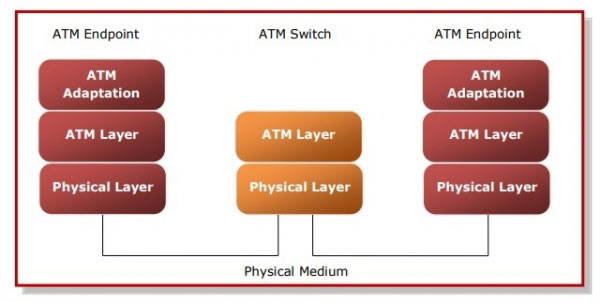Learn about Asynchronous Transfer Mode (ATM) in a computer network
Asynchronous Transfer Mode (ATM) or asynchronous transfer mode is a switching technique that uses time division multiplexing - TDM (Time Division Multiplexing) - to transmit data. ATM is a network technology that supports voice, video and data communication. ATM encrypts data into small, fixed-size cells so that they are compatible with TDM and transmitted via physical media.
Features of ATM
ATM technology provides dynamic bandwidth especially suitable for fast traffic.
All data is encrypted into identical cells. Hence, data transmission is simple, consistent and predictable. Uniform package size ensures that mixed flow is handled efficiently.
The size of an ATM cell is 53 bytes, 5-byte header and 48-byte payload. There are two different cell formats - User Network Interface (UNI) and Network Network Interface (NNI).
"Asynchronous" implies that the cells do not need to be transmitted continuously as in synchronous paths. Cells only start sending when data is being sent.
- The ATM header has a small size of 5 bytes. This reduces packet overload, thus ensuring an efficient use of bandwidth.
- ATM divides the bandwidth requirements of the physical layer flexibly. It offers scalability both in size and in speed.
 The functional reference model of ATM
The functional reference model of ATM
ATM reference model
The ATM reference model consists of 3 layers:
1. Physical layer
This layer corresponds to the physical layer of the OSI model. At this layer, cells are converted into bit streams and transmitted through the physical medium. This layer has two sub-layers - the PMD (Physical Medium Dependent) sub-layer and the TC (Transmission Convergence) sub-layer.
2. Layer ATM
This layer is comparable to the data link layer of the OSI model. It accepts 48-byte segments from the layer above, adds a 5-byte header to each segment, and converts it into 53-byte cells. This layer is responsible for individual cell routing, traffic management, multiplexing, and switching.
3. ATM Adaptation Layer (AAL)
This layer corresponds to the network layer of the OSI model. It provides utilities for existing packet switched networks to connect to the ATM network and use all of its services. This layer takes the data and converts them into segments of fixed size. Transmission can be fixed or variable data rates. This layer has two sub-layers - the Convergence sub-layer and the Segmentation and Reassembly sub-layer.
See more:
Learn about the Telnet protocol
Learn about Wireless Sensor Network (WSN)
Desk Area Network (DAN)
Learn about WiMAX Internet
Learn about Personal Area Network (PAN)
Learn about POE (power over Ethernet cable)
- Data Center Network Security | Next Generation Firewall
- Help Protect Your Digital Assets Against Cyber Threats Network Security
- Network Security Software | Search Learn more Security NET
- Spam filter, Antivirus software, Proxy server | Network access control (NAC)
- Review and analysis Managed Application Support Services for AWS
Operate and exploit advertising by iCOMM Vietnam Media and Technology Joint Stock Company.
Adress: 99 Nguyen Tat Thanh, To 2, Khu 6, Thi tran Tan Phu, Tan Phu, Dong Nai.
Email: phuongtran2191@gmail.com | Tel: (+84) 984654960
Editor in chief: Tran Nha Phuong
Company: Lucie Guillot (Nha Phuong Tran)




